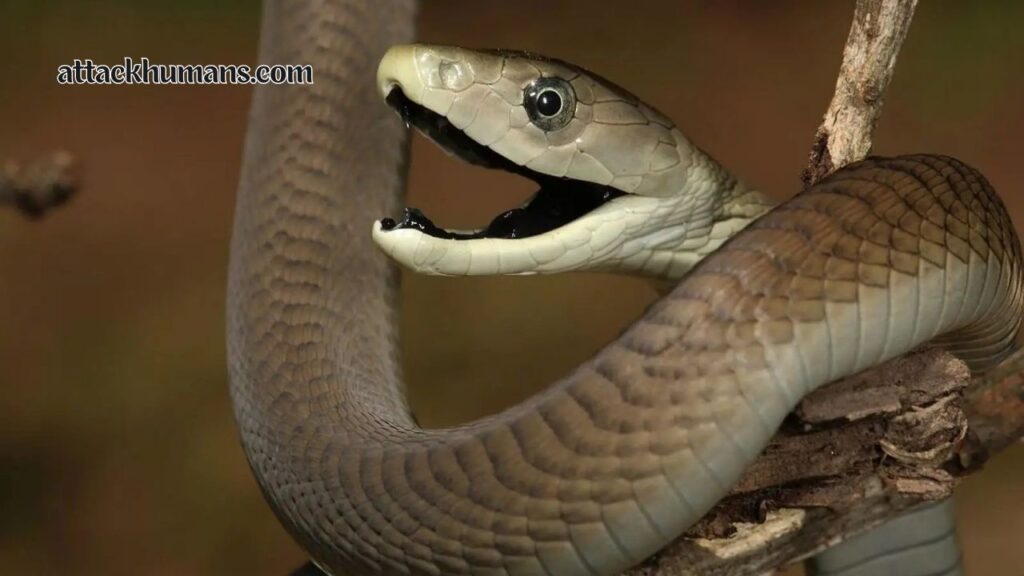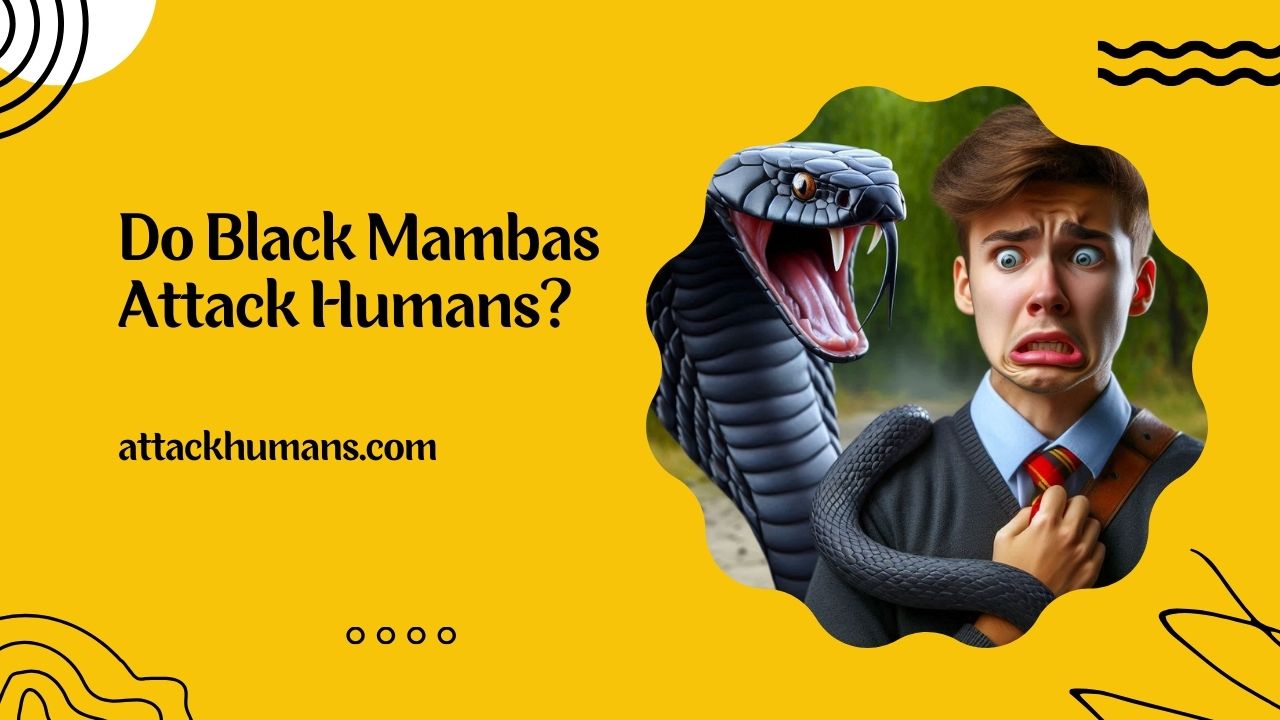Do Black Mambas Attack Humans? Black Mambas typically avoid humans, but they can become aggressive and strike if they feel threatened.
The Black Mamba is widely considered one of the deadliest and most feared snakes on Earth.
Known for its impressive speed, potent venom, and aggressive defensive behaviors, it is often the subject of fear and fascination.
But does this notorious snake actively seek out humans, or is its reputation exaggerated?
This article explores the reality of human encounters with Black Mambas, delving into their behaviors, the reasons behind their attacks, and the steps people can take to minimize the risk of potentially dangerous interactions.
By understanding these creatures, we can replace fear with respect and take appropriate precautions when in Black Mamba territory.
Contents
What is a Black Mamba?
Physical Characteristics
Black Mambas are the longest venomous snakes in Africa and the second-longest in the world, after the King Cobra.
Typically, they measure between 6.6 to 9.8 feet, though some specimens have reached up to 14 feet. [Do Black Mambas Attack Humans?]
Despite their name, Black Mambas are not actually black; their bodies are often gray, olive, or brown, with a sleek and streamlined build that facilitates their remarkable speed.
The inside of their mouths, however, is a striking jet-black, a feature they display as a warning sign when threatened.
Their large, smooth scales contribute to their appearance, giving them an almost metallic sheen in the sunlight.
Habitat and Distribution
The Black Mamba is native to sub-Saharan Africa, with a range that spans across various countries including South Africa, Namibia, Kenya, Tanzania, Uganda, and parts of the Congo.
They thrive in savannas, rocky hills, open woodlands, and areas where there are dense bush and rocky outcrops that provide both sunlight and shelter.
They are versatile and adaptable, which allows them to live comfortably in areas where they can avoid large human populations.
Black Mambas are both arboreal and terrestrial, meaning they are equally comfortable on the ground and in trees. [Do Black Mambas Attack Humans?]
This adaptability allows them to hunt a variety of prey and seek out the most favorable conditions for basking and shelter.
Do Black Mambas Attack Humans?
Behavioral Traits
Despite their reputation as aggressive snakes, Black Mambas are inherently shy and reclusive. When given the chance, they prefer to flee from perceived threats rather than engage.
They use their remarkable speed—capable of reaching up to 12 miles per hour—to escape danger quickly. However, when confronted and feeling cornered, Black Mambas can exhibit highly defensive behaviors, which can be mistaken for aggression.
They will flatten their bodies, raise their heads, and open their black mouths in a menacing display, often accompanied by loud hissing. [Do Black Mambas Attack Humans?]
Reasons for Aggression
A Black Mamba will attack a human only in self-defense, and even then, this response is driven by a sense of imminent danger.
Common situations that lead to Black Mamba attacks include sudden encounters in their natural habitat where they may feel cornered or when they are inadvertently stepped on or surprised.
During mating season, males may be more territorial and prone to defensive strikes if their nesting areas are disturbed.
However, in nearly all cases, these snakes prioritize escaping over confrontation. [Do Black Mambas Attack Humans?]
How Black Mambas Defend Themselves
When cornered, a Black Mamba will initially display a warning posture to deter the threat. [Do Black Mambas Attack Humans?]
They will raise the front third of their body off the ground, open their mouth to reveal the dark interior, and emit a loud, rattling hiss.
If the perceived threat does not retreat, the snake may lunge forward with a rapid strike, delivering multiple bites in quick succession.
Black Mambas possess long, hollow fangs at the front of their mouths that inject venom deep into their target with each strike.
Venom and Its Effects on Humans
The venom of a Black Mamba is a cocktail of neurotoxins and cardiotoxins, making it incredibly potent. [Do Black Mambas Attack Humans?]
Once injected, the venom begins to shut down the nervous system, leading to symptoms such as drooping eyelids, muscle weakness, blurred vision, and difficulty breathing.
Without prompt medical treatment, a person can experience respiratory failure, cardiac arrest, and eventually death. [Do Black Mambas Attack Humans?]
Black Mamba venom is capable of killing a human within 20 minutes to a few hours, depending on the amount of venom injected and the individual’s response.
However, access to effective antivenom has significantly reduced fatalities in regions with proper medical facilities.
Statistics on Human Encounters
Though highly venomous, Black Mamba bites on humans are relatively rare. Most incidents occur when humans inadvertently provoke the snake, either by stepping on it or attempting to kill it.
Statistics show that the majority of Black Mamba attacks happen in rural areas, where encounters with humans are less frequent.
In regions where the snake is commonly found, local communities are often well-informed about the risks and practice avoidance techniques.
Additionally, recent conservation efforts have helped to educate people on how to live safely alongside these snakes. [Do Black Mambas Attack Humans?]

How to Avoid a Black Mamba Encounter
Precautions in Mamba Territory
For those living in or traveling through areas where Black Mambas are present, certain precautions can significantly reduce the likelihood of an encounter.
Wearing boots and long pants, especially when walking through tall grass or rocky terrain, provides some protection. [Do Black Mambas Attack Humans?]
Staying on well-cleared paths and avoiding areas with thick underbrush can also help. Many locals carry a stick or walking pole, which can be used to probe the ground ahead, giving the snake ample warning to flee.
Recognizing a Black Mamba
Black Mambas are unique in both appearance and behavior, which can help people identify and avoid them. [Do Black Mambas Attack Humans?]
Their olive-gray bodies, slender build, and distinctively black mouth make them stand out. Additionally, Black Mambas are active during the day, so extra vigilance is advised during daylight hours in regions where they are found.
Watching for movement in tall grass or near rock piles is a good habit for anyone in Black Mamba territory.
What to Do If You Encounter a Black Mamba
If you unexpectedly come across a Black Mamba, it’s essential to remain calm and slowly back away. Avoid any sudden movements, which may be perceived as a threat.
Do not attempt to approach, capture, or kill the snake, as this significantly increases the risk of a defensive strike. [Do Black Mambas Attack Humans?]
Give the Black Mamba plenty of space, as they are highly sensitive to vibrations and movement and will often retreat if they sense an escape route.
First Aid and Treatment for Black Mamba Bites
Immediate First Aid Measures
In the rare event of a Black Mamba bite, quick action is critical. The first priority is to seek emergency medical help immediately.
While waiting for medical assistance, keep the bite victim as calm and still as possible to slow the spread of venom.
Immobilizing the bitten limb and applying a pressure bandage (without cutting off circulation) can help delay venom absorption.
It’s important not to attempt sucking out the venom, as this can cause more harm. [Do Black Mambas Attack Humans?]
Importance of Medical Treatment
The venom of a Black Mamba acts rapidly, and antivenom is the most effective treatment. Seeking professional medical care is essential; without it, Black Mamba bites are almost always fatal.
Hospitals in areas where Black Mambas are found often stock antivenom specific to their venom. [Do Black Mambas Attack Humans?]
If possible, note the time of the bite and provide emergency responders with as much information as possible to assist in treatment.
Antivenom and Recovery
Antivenom for Black Mamba bites is typically administered intravenously in a clinical setting. The sooner the antivenom is given, the better the chances of survival.
Even after receiving antivenom, the patient may require additional treatments, including respiratory support. [Do Black Mambas Attack Humans?]
Recovery time can vary depending on the severity of the bite and the individual’s response, but with prompt treatment, many people can make a full recovery.
See Also: Do Tigers Attack Humans For No Reason?
FAQs
Are Black Mambas the most dangerous snake?
Yes, Black Mambas are among the most dangerous due to their potent venom, speed, and defensive aggression when threatened.
How fast can Black Mambas move?
They can reach speeds of up to 12 miles per hour, which makes them one of the fastest snakes in the world. [Do Black Mambas Attack Humans?]
What is the mortality rate of a Black Mamba bite?
Without treatment, the mortality rate is nearly 100%, but with access to antivenom and proper medical care, survival rates improve drastically.
How long do you have to get treatment after a bite?
Immediate medical attention is critical; symptoms can progress quickly, so ideally, treatment should begin within 30 minutes to an hour.
Are Black Mambas protected by conservation laws?
In some areas, Black Mambas are protected, particularly where habitat loss threatens their populations. They are not currently endangered but are an essential part of their ecosystem.
Conclusion: Do Black Mambas Attack Humans?
Black Mambas are formidable creatures with a reputation for aggression, but they do not seek out human interactions.
Instead, they will go to great lengths to avoid confrontation, attacking only when they feel directly threatened. [Do Black Mambas Attack Humans?]
By understanding the behavior of Black Mambas, learning to recognize them, and knowing what to do in their presence, people can coexist safely with these remarkable snakes.
Black Mambas play an important role in their ecosystems, helping control populations of rodents and other small animals.
Through education and respect, we can reduce fear and learn to appreciate the unique role these snakes play in the natural world.

Hello, I am Rosa Ellis, a mother of two and a wildlife blogger. I grew up in New York City, but I love exploring forests. I’ve traveled to places like Yellowstone National Park and the Amazon Rainforest to see animals up close. I know a lot about animal behavior and which animals can be dangerous to humans. Thanks for visiting my blog!

